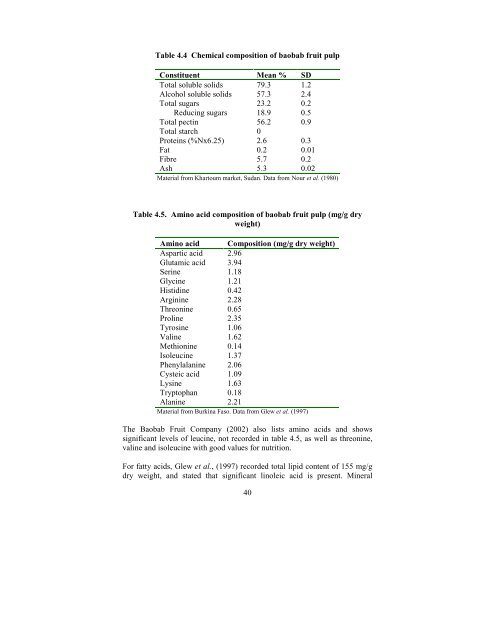Baobab Monograph.pdf - Crops for the Future
Baobab Monograph.pdf - Crops for the Future
Baobab Monograph.pdf - Crops for the Future
You also want an ePaper? Increase the reach of your titles
YUMPU automatically turns print PDFs into web optimized ePapers that Google loves.
Table 4.4 Chemical composition of baobab fruit pulp<br />
Constituent Mean % SD<br />
Total soluble solids 79.3 1.2<br />
Alcohol soluble solids 57.3 2.4<br />
Total sugars 23.2 0.2<br />
Reducing sugars 18.9 0.5<br />
Total pectin 56.2 0.9<br />
Total starch 0<br />
Proteins (%Nx6.25) 2.6 0.3<br />
Fat 0.2 0.01<br />
Fibre 5.7 0.2<br />
Ash 5.3 0.02<br />
Material from Khartoum market, Sudan. Data from Nour et al. (1980)<br />
Table 4.5. Amino acid composition of baobab fruit pulp (mg/g dry<br />
weight)<br />
Amino acid Composition (mg/g dry weight)<br />
Aspartic acid 2.96<br />
Glutamic acid 3.94<br />
Serine 1.18<br />
Glycine 1.21<br />
Histidine 0.42<br />
Arginine 2.28<br />
Threonine 0.65<br />
Proline 2.35<br />
Tyrosine 1.06<br />
Valine 1.62<br />
Methionine 0.14<br />
Isoleucine 1.37<br />
Phenylalanine 2.06<br />
Cysteic acid 1.09<br />
Lysine 1.63<br />
Tryptophan 0.18<br />
Alanine 2.21<br />
Material from Burkina Faso. Data from Glew et al. (1997)<br />
The <strong>Baobab</strong> Fruit Company (2002) also lists amino acids and shows<br />
significant levels of leucine, not recorded in table 4.5, as well as threonine,<br />
valine and isoleucine with good values <strong>for</strong> nutrition.<br />
For fatty acids, Glew et al., (1997) recorded total lipid content of 155 mg/g<br />
dry weight, and stated that significant linoleic acid is present. Mineral<br />
40

















